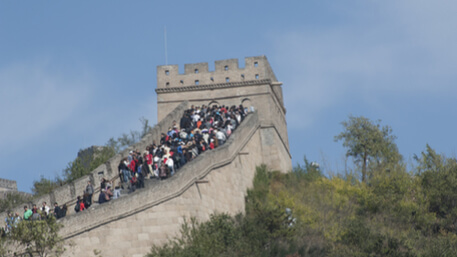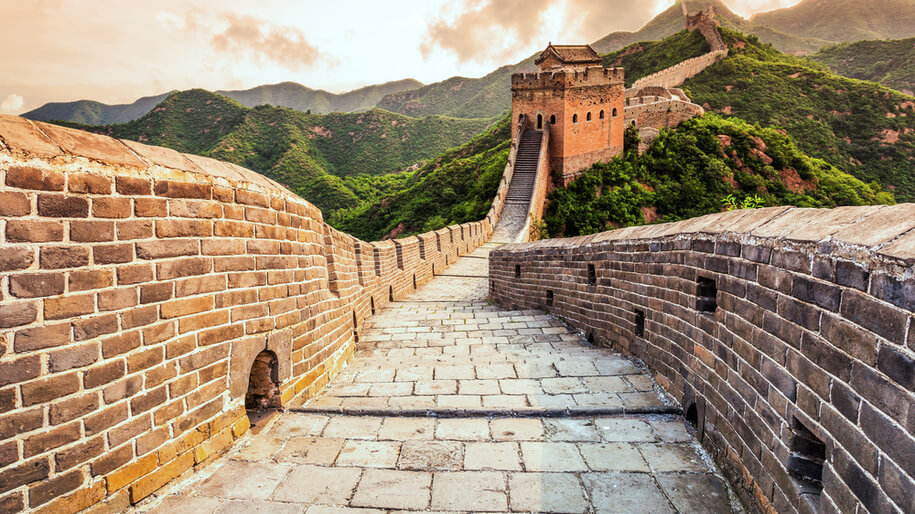19 Sep
2017
Guide To Your Great Wall Of China Visit
Transportation & Travel By China Car Service Comments Off on Guide To Your Great Wall Of China Visit
Getting To The Great Wall Of China

The 5,500.3 miles (8,851.8 kilometres) of the Great Wall of China stretch far across Northern China. From Hushan, in Liaoning, to Jiayuguan Pass. It travels over deserts, grasslands, mountain ridges, and finds its end on the waters of China’s Eastern coast.
Most sections of the Great Wall that are commonly visited and photographed were built during the Ming Dynasty (1368–1644). Due to factors such as erosion, adverse weather conditions, and negligent human behavior, over 30% of the Great Wall has either deteriorated or disappeared completely. The most popular and well-preserved sections are situated around China’s capital city, Beijing.
Being one of the most popular tourist destinations in China, there are multiple routes to reach the Great Wall. The wall is approximately an hour and a half drive from Beijing. There are no direct buses/trains from Beijing to the Great Wall, which means you’d need to make transfers along the way. This might be a bit complicated in a foreign environment, as the majority of the population cannot speak nor understand English. There are tour buses that can take you to the Great Wall direct. However, make no mistake, year round these buses will usually be extremely crowded. The Great Wall is just attractive to foreign tourists as to the millions of local tourists wanting to see the glory of their home country. You’ll be guaranteed an authentic“Chinese tour experience,” huddled from place to place along with the masses.
For a non-crowded and much easier experience, we recommend taking a private taxi or guided tour. Not only will you avoid the discomfort of crowds and long queues, you’ll be able to appreciate the The Great Wall at your own pace. Skip the crowds. Experience, first-hand, the story behind the longest human construction in history.
Preparing for a trip to Beijing? A private transfer with a professional driver is the safest, quickest way to travel from airport to the city. China Car Service is a trusted transportation service helping business travelers for almost two decades. We provide door-to-door service at competitive prices.Make your journey stress-free and contact our 24/7 team at Bookings@ChinaCarService.com with questions, or get a quote below. Use this promo code: 10CARBLOG to get a $10 discount on your 1st service. |
What You Should Prepare Beforehand
 Clothing
Clothing
When visiting the Great Wall of China, it’s best to dress as comfortably as possible. You’ll be doing a fair amount of walking and hiking along the wall. Some sections can get quite steep. Make sure you have comfortable shoes and bring a sweater or jacket along, in case it gets cold or windy.
Food & Drink
Depending on your schedule, you may be hiking for about 2 – 3 hours. Bring some snacks and plenty of water; be sure to prevent dehydration. The Badaling Section is the only section where you’ll have the chance to buy something on the Great Wall. In case you forget, you can purchase some snacks and water in Badaling. However, the merchants seize this opportunity to raise their prices comparable to airports and amusement parks.. It’s important to note that the only bathrooms are at the entrance, so drink your water smartly; there will be no washroom halfway.
Useful Extras
Since Mother Nature is unpredictable, it’s best to be prepared for all weather conditions. An umbrella is a popular and useful accessory for your trip to the Great Wall. It’ll protect you from both sun and rain. And don’t forget to wear sunscreen and a pair of sunglasses, the sun can be unforgiving. We’d also recommend taking a hat for further protection.
The Best Sections To Visit
The Great Wall’s most famous sections are located in its suburban areas. The three most visited sections are Badaling (most popular amongst local tourists), Mutianyu (most popular amongst foreign tourists), and Juyongguan (one of the most spectacular Great Wall Forts). These sections are all well restored, easily accessible, and provide straightforward hiking trips. They’re known to be quite family/child friendly. If you’re looking to travel to the wall during your flight’s long layover, or just have a bit of time to spare on your trip; a visit to any of these sections is your best bet. The quickest way to get to these sections of the Great Wall from Beijing, is by traveling by car, especially during peak seasons, as trains and buses fill up fast and you may have to wait quite some time for the next lift.
Less Crowded, but accessible sections

Although less crowded, certain sections have also been developed into popular and scenic spots, but are less crowded, allowing for better photographic opportunities and for you to explore the new 7th World Wonder at a more leisurely pace. Jinshanling (popular hiking route) and Simatai (incredible display of architectural features) have been equipped with cableways to take you up the Great Wall if you would like to save some time. Certain parts along Simatai are restricted and since one needs to go through the Gubei Water Town to reach Simatai, you are required to make a reservation at least one day in advance on Water Town’s official website if you wish to visit the Great Wall.
Another section worth visiting is the Huangyaguan Pass. Built along the mountains, it provides a wonderful hiking route for tourists with captivating views down the steep mountain. It is one of the best Great Wall sections to visit from Tianjin and is also where the annual Great Wall Marathon is held in May.
In addition to admiring the Great Wall, Xiangshuihu is a site rich in heritage and tradition. After your climb, you can pay a visit to the Health Preserving Valley located to the north of the mountain. The valley is a relatively short hike of 1.6 miles (2.5 kilometres). There you will find health preserving aphorisms left by famous doctors, secret recipes written on the stones, and hundreds of medicinal herbs across the area.
Wild sections
Very popular amongst hikers and adventurous travellers, Wild Great Wall are the sections that have not been renovated and therefore have kept their original appearance. Although they are broken-down they still reveal the history and true architectural magic of the wall. Popular wild sections include Jiankou and Gubeikou.





 Clothing
Clothing
